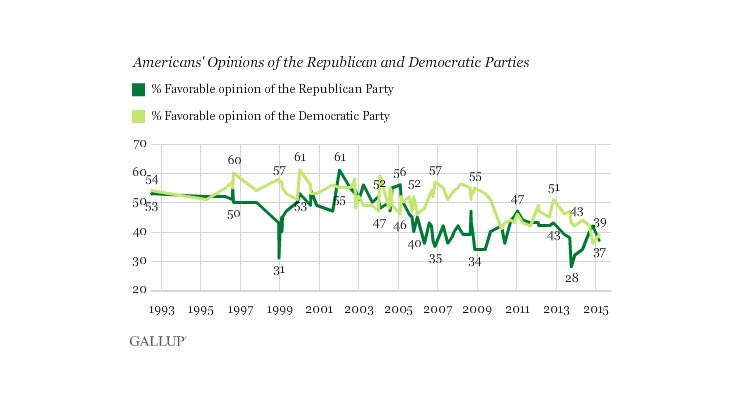
New Gallup Poll shows for first time ever both major parties fall to below 40 percent favorability
Democracy, elections and voting at Democracy Chronicles
In a new post on Ballot Access News, “Gallup Poll, for First Time, Shows Neither Major Party Viewed Favorably by As Much as 40% of the Electorate,” publisher and editor Richard Winger reveals the stunning drop in support for the two parties of our so-called two party system. Take a look:
On March 16, Gallup released this poll, asking voters whether they have a favorable or an unfavorable impression of the Democratic Party, and the same question for the Republican Party. Gallup has been taking this poll starting in 1992. For the first time in the history of this poll, neither major party registers a favorability rating of even 40%. Many years ago, both major parties had positive ratings above 60%.
If the United States had nondiscriminatory election laws and practices relating to ballot access, debates, and campaign finance, it is obvious that new parties would arise and gain substantial support, just as they have in Great Britain and Canada.
Even now, the United States has a record number of one-state parties that are non-ideological and not associated with any particular interest group. Independence Parties exist in Alabama, Florida, Minnesota, Mississippi, New York, and South Carolina. Parties named “Independent Party” exist in Connecticut, Delaware, Florida, Hawaii, and Oregon. The Moderate Party exists in Rhode Island. South Carolina has a centrist party named “American Party.” Massachusetts has a centrist party, the United Independent Party. Colorado has a Unity Party. Iowa has a New Independent American Party. New Jersey has the D-R Party. The United States had a centrist, non-ideological party called Americans Elect during 2010, 2011, and the early months of 2012, but it no longer exists. In the past there were very few parties, either state or national, that were non-ideological and didn’t represent a particular interest group. The birth and growth of such parties is a sign of the unhappiness with the Democratic Party and the Republican Party.
According to the Gallup Poll announcement by Lydia Saad, there is a long-term pattern:
Over the years, Americans’ perceptions of the major parties have tended to conform to two patterns. At times — such as in 1992, 1996 and in the post-9/11 years of 2001 through 2005 — Americans viewed both parties favorably. At other times, the public viewed one party — typically the Democratic Party — much more favorably than the other. This was evident in late 1998 as the Republican-led U.S. House of Representatives pursued impeachment proceedings against then-President Bill Clinton, as well as from 2006 through 2008 as President George W. Bush’s popularity waned during the Iraq war; in 2009 at the start of President Barack Obama’s presidency; and again in 2013 during the government shutdown, when Republicans’ favorable rating plunged to 28%.
Richard Winger has spent nearly half a century as America’s leading advocate for third party access. To this day, his website Ballot Access News is the best place for complete coverage of the third party battle for ballot access.
Leave a Reply